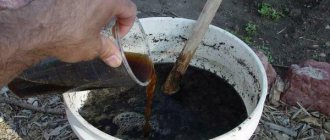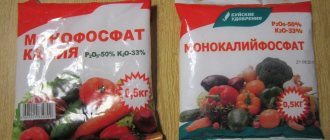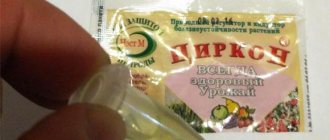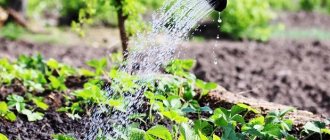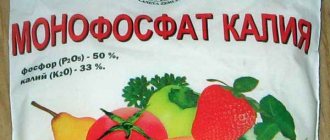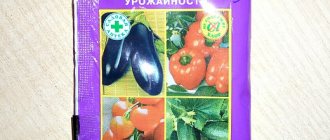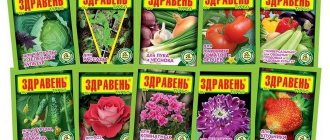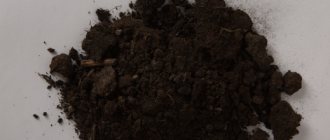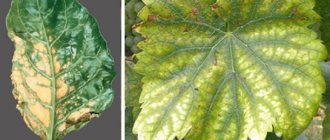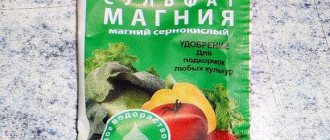Widely known organic fertilizers are manure and litter. But few people realize that potassium humate, a substance that has been used for more than half a century, is also of organic origin. It is recommended for improving soil, protecting plants and increasing the immunity of crops.
Humates are rightfully universal gardening products. The scope of application is wide: from the moment of processing the seed material to increasing the yield at the ripening stage.
Description, composition and mechanism of action of potassium humate
On sale you can find a variety of products called Potassium Humate. This does not mean that only one among the others is natural, and the rest are fake.
Differences in form and composition depend on the method of manufacturing the fertilizer: natural or artificial ingredients.
All types of humate (with microelements or dry, in tablet form) are substances with humic acids (over 81%).
The percentage of the remainder consists of amino acids, peptites, antibiotics and stimulants, enzymes. The ratio of additional substances differs between different manufacturers and release forms.
The mechanism of action is also not very different: stimulation of metabolic and biochemical processes. Obtaining fertilizer from coal and peat. In some cases from silt and certain types of soil.
The appearance of the fertilizer depends on the form:
- liquid - a natural substance obtained by processing peat;
- powder form - an artificially created drug;
- potassium humate with microelements: the second name is “Prompter”. It is a universal remedy. It is more used as a top dressing, which can be used every 2 weeks throughout the growing season. Then the application of humate Prompter is reduced to 1 time every 1.5 months. Obtained from bottom sediments of fresh water reservoirs (sapropel).
Interesting fact! Powdered fertilizer potassium humate can easily replace humus. If we carry out the ratios, we obtain the following data: 1 kg of humate will be equal to 1 ton of humus. At the same time, fertilizer in any form will help remove nitrates and toxic chemicals from the fruit.
General Tips
Specialists at the subsidiary farm Arzamas advise using potassium humate in a greenhouse to restore the root system of cucumbers.
After 2 months of active fruiting, there is a decline in yield and a deterioration in the quality and shape of cucumber fruits. The cucumber ripens crookedly, unevenly, and gradually becomes thinner. The reason is depletion and overload of the root system. It's time to feed the roots.
To resuscitate the entire bush, several sequential operations are performed:
- old spent shoots, damaged and withered leaves are cut off;
- cuts are made as close as possible to the main stem;
- pruning eases the load on the root system;
- Next, a solution of potassium humate is diluted at the rate of 1 liter of liquid fertilizer per 500-1000 liters of water (for drip irrigation);
- fertilizing takes effect within 2-3 days.
The plant growing company ORELSTART (Chelyabinsk) recommends using fertilizer for cereals - rye, wheat. Rapid germination of seedlings after sowing is noted.
Sodium humate is used primarily for processing onions.
The technical director of the company, V. Maleev, provides statistical data - the yield is 20-30% higher in those areas where the seeds were treated with this bioresource. By watering radish crops with potassium humate, the crop ripens faster by 7-10 days, the radish itself turns out juicy, without bitterness.
Differences from sodium humate
There is not only potassium humate, but also sodium humate. Two different substances that are obtained by treating humic acids with alkali. Treatment of plants with these fertilizers is identical. The question then becomes what is the difference between the two.
The differences are in the receipt of batteries. If you feed with potassium humate, the crop will receive potassium. The element is necessary for the full development and ripening of fruits. The fertilizer is a potassium fertilizer.
Sodium humate is used when there is an excess of potassium. Top dressing has negative and positive qualities (immunomodulator, stimulator of maturation and growth). In addition to its beneficial effect on soil and plants, sodium prevents the supply and nutrition of potassium to crops. It also helps increase toxins.
Since the substance is cheaper than potassium humate, gardeners quite often buy it. Considering the pros and cons of the two fertilizers, before purchasing, you should think about the resulting harvest and the taste qualities of the fruit.
What is this anyway?
Our gardeners and gardeners have loved humate for a very long time. It is easy to use, and the effect of using this natural supplement is extremely good and noticeable even to the naked eye.
It is obtained from completely natural ingredients. Potassium humate is produced from the remains of vegetation; extracts from peat, manure or even lake silt are also used for this. In some cases, brown coal is used as a raw material. The natural components of humate have a pronounced stimulating effect. Thus, pre-soaking the seeds sharply increases the degree of their germination. If you treat cuttings with it, the chances of their rooting increase significantly.
The fertilizer is equally useful for flowers and vegetable crops, fruit trees and potted plants. Simply put, it is universal. Contains a lot of potassium, phosphorus and other trace elements. But potassium humate is richest in humic acids. It is their action that helps to obtain truly clean products in conditions of ever-increasing environmental pollution.
Types of fertilizer
Potassium humate is one of the universal fertilizers. At the same time, it is effective and economical to use. When compared with other popular organics (manure, humus), in addition to the positive effect on soil and plants, the following points are highlighted:
- environmentally friendly product;
- convenient for storage;
- quickly affects the culture;
- there is no need to wait until ready, as is the case with humus;
- does not have a sharp unpleasant odor.
Before feeding plants, it is worth deciding on the form of fertilizer. But the choice is made by the farmer himself. They take into account the degree of need, timing, how convenient the method of application is, goals, and expected results.
Liquid
Since the substance is obtained from peat, the color is dark brown. This form is the most popular. It is famous for its high efficiency and rapid action on seeds and seedlings. Potassium humate is a concentrated liquid that is diluted in cold water before use.
Bottles containing the substance contain instructions for dilution. Also, this form, unlike others, can be used together or sequentially with nitrogen-containing and organic fertilizers
Powder
It is more characterized by farmers as an immunomodulator. After treatment with dry potassium humate, the plant grows faster and bears fruit.
Positive changes occur in the soil (humus formation, acceleration of microflora restoration). Subject to breeding. The recipe and proportions for preparation are indicated on the packaging of the powder.
What is it used for?
Potassium humate has long been famous for its high efficiency, which is why many owners of their own garden properties turn to it. Let's consider what are the main purposes of using this well-known and popular drug.
- Thanks to its application, both the physical and chemical properties of the soil on the site are significantly improved. The nutritional functions of the land are being restored.
- Properly applied potassium humate can reduce soil acidity and also enhance the effect of organic matter.
- When using potassium humate, the consumption rate of nitrogen fertilizers is noticeably reduced (by about 50%).
- Due to potassium humate, the effectiveness of drugs with various effects, namely herbicidal, insecticidal, and fungicidal, increases. Their toxic effects are neutralized.
- The type of fertilizing under consideration helps to grow healthy and environmentally friendly plants on the site. Not only the taste, but also the external characteristics of ripe fruits are improved. This applies to vegetables, berries, and various fruits.
- Potassium humate has a beneficial effect on the ability of plantings to remain healthy in adverse conditions. These include low temperatures.
- The drug effectively strengthens the root system of plants. Potassium humate can even restore damaged rhizomes of seedlings.
- Thanks to potassium humate, the harvest is more enriched with useful substances and microelements: proteins, minerals, carbohydrates.
- If you use the type of fertilizing under consideration, then in the soil and fruits it will be possible to reduce the existing percentage of heavy metals and other harmful impurities, which include nitrates.
- The drug strengthens the immunity of cultivated crops, making them less susceptible to various diseases and attacks by harmful parasites.
- Productivity increases noticeably already in the first year of using potassium humate.
- Potassium humate is an effective means for stimulating the growth of seedlings. The drug can have a positive effect even on indoor plants.
- After applying such fertilizing, the crop is stored much longer and survives transportation better.
The product shows good results if used for winter wheat, tomatoes, cucumbers, potatoes and other common vegetables, as well as ornamental flowers, strawberries and other berry crops. Potassium humate is often used to feed coniferous plants.
Areas of use
Potassium humate is a universal organic product for application to plants. With its help, a gardener can begin working with soil and planting material.
During the growing season, feed the crop until harvest. Before winter, it is also added so that the soil replenishes the lost supply of useful microelements.
You can use humate:
- during preparatory work with seeds and seedlings. Application takes place in liquid form, i.e., soaking is carried out;
- as a top dressing;
- after transplanting seedlings for better adaptation and rooting;
- for treating plants in open and closed ground at all stages of growth;
- for spraying during the flowering period. But the concentration of the solution should be low (maximum 0.1%);
- to improve the quality of organic nitrogen-containing fertilizers and soil reclamation.
The method of preparation and dilution of the working solution is indicated on the packaging. Step-by-step instructions will help prevent possible side effects.
Pre-sowing preparation
Potassium humate is often used as an immunomodulator. To do this, the seed material is soaked before planting in the ground.
The procedure contributes to a percentage increase in the germination of seeds, bulbs, and grains. Use a liquid diluted concentrate. Soaking time from 8 hours to 24 hours.
Growing seedlings
To improve immunity, potassium humate is applied to seedlings. The fertilizer does not lose its properties, the effect manifests itself throughout the growing season.
When applied to seedlings, we get the following result:
- increased resistance to infections and fungi;
- pest resistance;
- increased survival after transplantation into open ground;
- stable condition under negative environmental influences.
As a fertilizer
You don’t have to wait until the seedlings are planted to start feeding them. Incorporating fertilizer into the soil for the winter or early spring will help perennial crops “wake up” and annual crops to take root faster. Dry humate is chosen as a “saving drug”.
For convenience, the powder is mixed with sifted river sand. Absorption into the middle and lower layers occurs during snow melting. If the winter has little snow, they dig.
Composts are our everything
Surely every more or less experienced gardener knows how good organic compost is as a fertilizer. There’s just a problem: the tough parts of perennial plants, as well as weed seeds, take an extremely long time to rot, sometimes “delighting” garden owners even after several years. The peculiarity of humic acids is their ability to destroy the hard cellulose of dead plants. We invite you to take advantage of this property.
In addition, humates sharply increase the activity of saprophytic microflora, which also accelerates the maturation of compost and significantly improves its quality. To obtain high-quality fertilizer, about three months before application to the soil (at the end of spring, for autumn plowing), it is useful to irrigate the humus with a solution of humates, and the dose of fertilizer is calculated based on the need for approximately 10 grams of humic acids to decompose ten kilograms of compost.
Advantages and disadvantages
Definitely, the benefits of potassium humate cannot be exaggerated. The product has a stimulating effect for all types of garden crops. Its task is to have a beneficial effect on the roots of the plant, to force it to actively develop and strengthen.
Positive traits:
- suitable for all cultures;
- helps increase resistance to diseases, infections, pests;
- imparts frost resistance, increases the shelf life of the crop;
- reduces the need for nitrates in fruits;
- increased germination, accelerated fruiting time;
- ripening in general accelerates to 10-14 days;
- soil characteristics improve. There is an accelerated recovery of microelements;
- environmentally friendly fertilizer product.
There are only two negative aspects of the application. The first is that it cannot be applied if there is enough potassium in the soil. An excess of an element impairs the development of culture.
Secondly, strict adherence to dosages is required. Not a single organic product in concentrated form can have a beneficial effect on the earth and the plant.
Properties
The positive effect of the product on the composition and structure of the soil, as well as on the development of plants and fruits, has been proven for centuries.
For soil
- The soil becomes breathable and retains moisture well.
- The sandy soil begins to clump.
- Clay soil becomes loose.
- When insecticides and pesticides are used, heavy metal salts enter the soil, but they are converted into insoluble compounds that are not absorbed by plants.
For plants
- The percentage of seed germination increases.
- Seedlings grow faster and take root better in a new place.
- More plants survive in adverse weather conditions.
- The harvest increases.
- The quality of the fruit improves.
- Cuttings are accelerated.
- The fruits last longer.
How to prepare a working mixture
In 90% of cases, it is recommended to dilute potassium humate before use. A concentrated liquid product does harm instead of benefit. Instructions from the manufacturer provide for different dosages for dilution.
Depends on the type of crop, the need for the element, the condition of the soil, and the stage of development. If the solution is needed for soaking seeds, then stirring 0.5 g in a liter of water is enough. Processing times vary from 8 to 48 hours.
Watering/spraying also takes place according to different schemes. To apply under the root, the ratio of substances is 1 tbsp. l. to 10 liters (potassium humate is stirred in water). Spraying: a less concentrated solution is required (3 g of fertilizer per 10-liter bucket).
Liquid organic fertilizer is often recommended for treating fruits after spraying with pesticides. This is how detoxification is carried out. Ratio: 50 g powder + 50 g sand. The consumption of the received funds is 10 square meters. m.
Need to know! In addition to powder, tablets and concentrate, you can buy potassium humate in the form of a gel/paste. The drug is more expensive than others, but more effective. The composition contains the most active molecules, which ensures an increase in the percentage of penetration.
Release forms
Humate +7 has three consistency options:
- Powder (granules). Use after dissolving in water. The concentration of the working fluid is easy to adjust.
- Liquid concentrate. The drug is intended for dilution with water; it is not used in its pure form. It costs more than the powder product and has a shorter shelf life. It is easier to prepare a solution than from a powder, which allows you to use the concentrate to treat large areas.
- Pills. They consist of compressed powder, but dissolve quickly. Easy to calculate dose; no measuring or weighing required.
Instructions for use of the prepared solution
Potassium humate, regardless of purpose, must be diluted according to the manufacturer's instructions. Recommendations apply separately to crops and species.
For cereals
The farmer himself must choose the method of application for grain crops. A liquid concentrate is recommended for processing seed material and spraying. For effective use, it is suggested to dilute 200 ml of potassium humate in 10 liters of water.
Application depends on the growing season:
- first leaves, flowering - corn;
- budding, then after 2-3 weeks repeat the procedure - buckwheat;
- tillering, first inflorescences – sorghum, millet, oats, barley, rye, wheat
For vegetables
In this case, fertilizing (foliar, under the root) should take into account the type of crop:
- for cucumbers and tomatoes, the solution is standard (dilute 100 ml of potassium humate in 10 liters of water). Number of applications/treatments – up to 4 times;
- leafy for all vegetables (including tomatoes) 50 ml per 10 l. Consumption depends on the age of the seedling (per 1 sq. m. from 3 to 10 l);
- carrots, zucchini, cabbage and beets are treated 4 times per season with a standard solution.
Is it suitable for all crops?
Experienced gardeners know that there are no truly universal fertilizers. So is this remedy as good as we just talked about it? Let us assure you right away: today there are no crops that would react negatively to humate. Almost always, the effect of its use is closely related to the characteristics of the soil on which your garden stands.
Note that fertilizers of this type are extremely useful on soils that contain very little iron. In addition, fertilizing with potassium humate is useful on alkaline (especially on them), saline and podzolic soils. But pouring a solution of the product onto black soil is pointless, since you still won’t notice any special effect. In addition, agronomists have identified several crops that respond particularly strongly to the addition of this substance to the soil:
- All nightshades respond well (including potatoes and tomatoes), as well as beets (and fodder too).
- Almost all grains show significant increases in yield.
- Legumes practically do not change the indicators in any way.
- Under normal conditions, sunflower and pumpkin do not react to potassium humate; its use is not advisable.
It is no coincidence that we emphasized that the latest plant species do not grow under “normal” conditions. If it's been a bad year or you've planted them in poor quality soil, humic acids can work wonders! In a word, you should experiment for yourself, making sure of the effectiveness (or ineffectiveness) of this product in the conditions of your garden.
Thus, potassium humate is still universal. Its use can be recommended in almost any cases. You can read about when you should not use it at the end of our article.
Fertilizer compatibility
At the beginning of the season, the farmer creates his own calendar of treatments and field work with plants. At the same time, treatments with fertilizers, fungicides and other means are taken into account. If you decide to use potassium humate during the growing season, it means:
- Do not treat the soil together with phosphorus-containing preparations or potassium nitrate. The gap between applications can be at least a week.
- Perennial crops are processed several times per season. But annual plants - only before budding.
Precautions during operation
To avoid a negative reaction from the use of humates, you need to adhere to the dosage and know about the compatibility of fertilizers. This product cannot be combined with superphosphates and calcium nitrate. This can lead to the accumulation of insoluble salts in the soil.
Potassium humate is a universal complex preparation. It improves growth and development indicators, helps to achieve better yields.
Useful articles from the “Useful Tips” section:
Useful articles for gardeners:
- Sowing pepper in January 2022: when to plant, timing, favorable days
- Radish
- What to plant in the garden: when and how to plant, list of vegetables and berries
- Work in the garden and vegetable garden in November: what needs to be done
- Fertilizer for potatoes: what, when and how to fertilize
- Treatment of currants in the spring in 2022 from diseases and pests: timing, best means
- Gardener's sowing calendar for May 2022: favorable days
- Sowing cucumbers in open ground with seeds in 2022 according to the lunar calendar: favorable days
- Sowing sorrel in 2022 according to the lunar calendar: when to sow, favorable days
- Planting gatsaniya in 2022 according to the lunar calendar: favorable days, timing
Analogues of potassium humate
It is not necessary to purchase potassium humate. You can always use similar products that contain mineral supplements. “Humate + 7 iodine” has proven itself well. Also offer:
- Gibbersib is a phytohormonal substance;
- Hyteroauxin – growth activator;
- Athlete – growth regulator;
- Gumifield is a stimulant.
Each drug has beneficial properties and special rules for use. Before starting work, be sure to study the instructions for use, dosage and expiration dates.
Storage
Humate +7 can be stored for 3 years from the date of issue. An expired drug loses its beneficial properties.
For storage, choose places and rooms:
- dark;
- with low air humidity;
- cool (+5…+35°C);
- inaccessible to children, animals, birds.
Do not store food, medicine, or feed near the drug.
The working solution remaining after fertilizing can be stored for about a month; reviews from gardeners indicate that the product remains effective.
To do this, pour it into a plastic or glass container and seal it tightly. The container should be opaque or made of dark glass.
Keep in a dark, cool place. Unnecessary solution can be poured down the drain.
